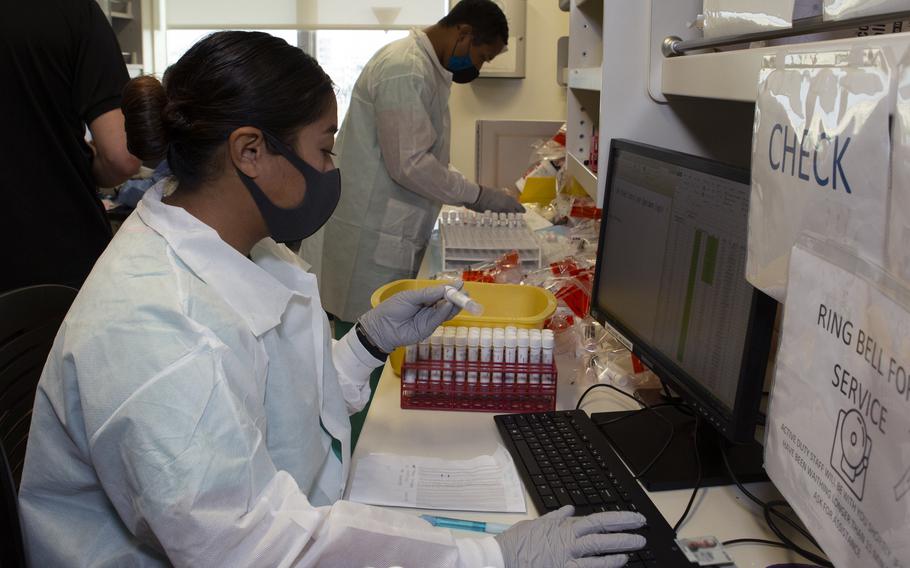
Petty Officer 2nd Class Bridget Greene inventories COVID-19 test samples at U.S. Naval Hospital Okinawa, Aug. 15, 2020. (Lucas Vega/U.S. Marine Corps)
Stars and Stripes is making stories on the coronavirus pandemic available free of charge. See more stories here. Sign up for our daily coronavirus newsletter here. Please support our journalism with a subscription.
Okinawa has declared a local emergency as the island prefecture again paces Japan’s record-breaking wave of COVID-19.
“The momentum of the infection has not slowed down, and the further spread of the infection has become a reality,” wrote prefectural Gov. Denny Tamaki in a statement Thursday. He cautioned that summer events and vacation crowds would exacerbate the rising coronavirus tide.
The prefectural emergency calls on its population to wear masks, limit outdoor dining to groups of four, refrain from nonessential outings where social distancing cannot be maintained and avoid visiting people who are at risk of serious illness, Tamaki said.
III Marine Expeditionary Force, headquartered on Okinawa, repeated the prefectural announcement Friday and reminded its population to take the same precautions.
“While we are guests in Okinawa, it is also our home,” the III MEF said in a Facebook post. “It is the responsibility of each and every one of us to come together and help mitigate the spread of COVID-19.”
Hospitals are becoming strained as the number of new patients increases, according to Tamaki. On Sunday, 551 people were hospitalized with COVID-19 on Okinawa, 20 of them with severe symptoms, according to the Okinawa COVID-19 information website.
New cases of COVID-19 are arising faster than they ever have in Japan, which reported 200,870 Saturday, high above the pandemic peak of 104,345 on Feb. 3 during the omicron wave, according to the Johns Hopkins Coronavirus Resource Center. Japan on Sunday reported 176,492, according to Johns Hopkins.
The BA.2 omicron subvariant was responsible for the surge in new cases in Japan, the country’s National Institute of Infectious Diseases reported July 7. However, the institute predicted the BA.4 and 5 subvariants would soon predominate.
“In particular, the BA.5 lineage may become the mainstream lineage in Japan in the future and could be a factor in increasing the number of infected people,” according to the institute report.
BA.5 as of mid-July accounts for most of the new cases in the United States, according to the Centers for Disease Control and Prevention. It is “the most transmissible variant detected yet,” the director general of the World Health Organization, Tedros Adhanom Ghebreyesus, said at a media briefing Wednesday.
Okinawa had the highest per capita increase of the 47 prefectures in Japan, the infectious disease institute reported. Saturday, the prefecture reported its highest one-day total of the pandemic, 5,297, according to the COVID-19 information website.
Tokyo on Friday posted 34,995 new cases of the coronavirus respiratory disease, its highest one-day total of the pandemic, thus far, according to the Tokyo Metropolitan Government. Nearly half, 47%, of the available hospital beds are full for a total of 3,333 patients, of whom 79 have severe symptoms.